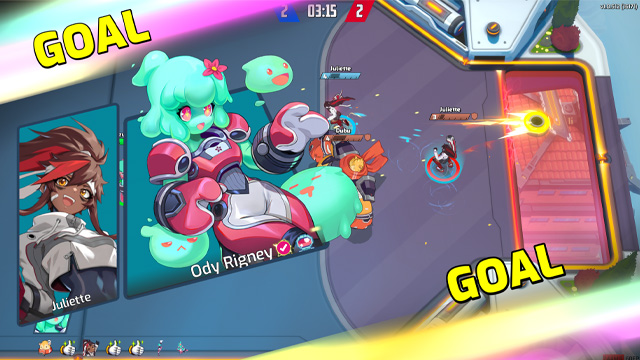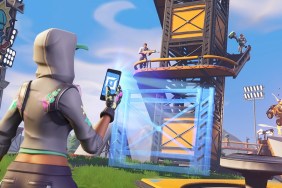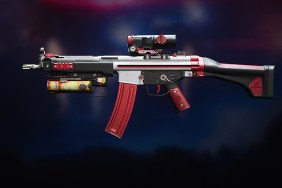Omega Strikers developer Odyssey Interactive is aggressive in its attempt to create the next big thing. Our preview began with Riot Games alumni Richard Henkel and Dax Andrus outlining their strategy, and the confidence in what they’re creating is admirable. They want their baby to overtake League of Legends, Fortnite, Rocket League, and co. as the live service game you play every night. To achieve this lofty task, they’ve come up with a plan — and it’s a smart one.
They want to release a competitive game that blends intuitive gameplay with a rewarding mastery curve, characters that players will love, a “best-in-class” live service infrastructure, and a natively cross-platform experience. They want it to focus on the community by making it free-to-play but not pay-to-win with zero loot boxes, and with new updates dropping every two weeks. Finally, they’re courting Twitch streamers and YouTubers with a unique ‘Creator Versus’ league, where content creators’ communities square off against one another and the winning creator earns a 1% share of all net revenue at the end.
But for any of this to come to fruition, Omega Strikers needs to be fun. Fortunately, it is — blending relatively simple mechanics with a deceptively high skill ceiling, this has potential unlike many other pretenders to the live service throne. Odyssey call it a blend of League of Legends, Rocket League, and Smash Bros., which seems an untenable combination, but it makes sense.
Why Omega Strikers could be the next big thing
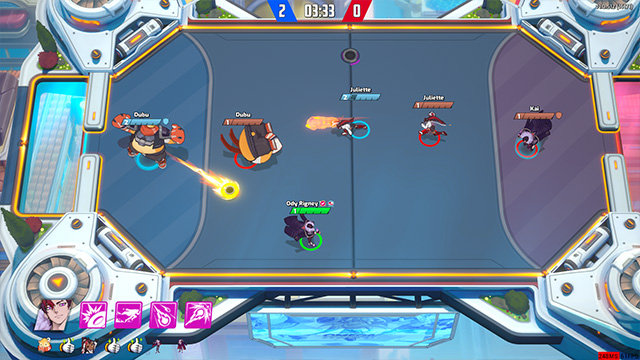
Henkel calls it a “3 vs 3 knockout striker” game where two teams try to get the puck into their opponents’ goal. To achieve this, they can attack and eliminate the other players with character-specific abilities a la LoL, or just blast them off the edge of the arena a la Smash Bros. You control these abilities as you would in a MOBA, keeping an eye on your cooldowns and making sure you have them available for when you need them.
Each character has their own strengths, weaknesses, and moves, from the giant hamster Dubu (I’d die for him) who places down bowls of food to block shots, to the brawler X whose spinning attacks can stun multiple enemies at a time. The characters have their own unique visual charm, and while it currently lacks the diverse roster of other character-based games — there are a few too many anime protagonists for my liking — there are plenty more additions on the way.
It’s easy to pick up and play Omega Strikers without thinking too much about the abilities, but there’s plenty of room to master each character and dominate a match with well-timed attacks. This is where the League of Legends influence comes in, as a skilled team can combine their characters’ movesets to create a force to be reckoned with. However, unlike League, there’s still some room for newcomers to enjoy themselves without tired veterans typing “KYS” in all-chat — it’s perfectly possible to run around smacking the ball while hoping for the best.
More business model than game?
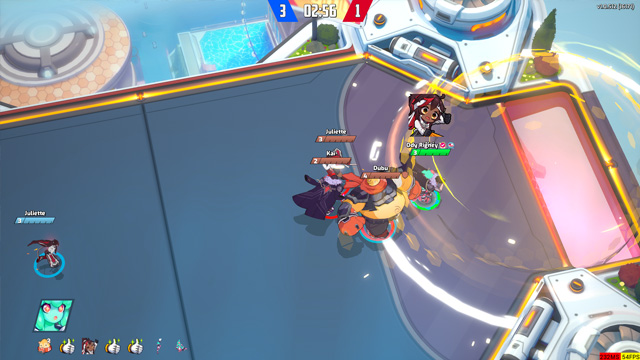
The biggest question mark looming over Omega Strikers is if new players will feel compelled to master its intricacies. The combination of a sports game with MOBA abilities takes some getting used to, and it felt as though some teammates and opponents really didn’t know what they were supposed to be doing — players assigned goalie would frequently leave their post, or would overlook the puck entirely in favor of just attacking other players. There are mechanics here that don’t immediately gel and take some getting used to, something which has stifled the success of other competitive multiplayer games.
This is where Odyssey hopes Omega Strikers’ partnerships with content creators will come in. Its small team doesn’t have the marketing power of gaming’s major publishers, so it’s reliant on word of mouth to keep people playing. The verified creator perks are the starting point — content creators over a certain threshold of popularity can apply for exclusive in-game perks such as custom emotes, Twitch drops, and an in-game verified badge similar to Twitter’s blue checkmark. They can also add social links to their profiles, letting players click on their Twitter, Twitch, or YouTube channels directly from the game.
For creators, this means that if they climb the leaderboards, other Omega Strikers players will be compelled to check out their social channels. For Odyssey, this theoretically means marketing-savvy creators can use the game as another platform to increase their visibility. The Creator Versus mode then lets creators actually earn money from the game by way of their community’s performance — Odyssey will be hoping that creators will encourage their audience to play the game in order for them to top the leaderboard and earn that revenue share.
Is Omega Strikers worth playing?
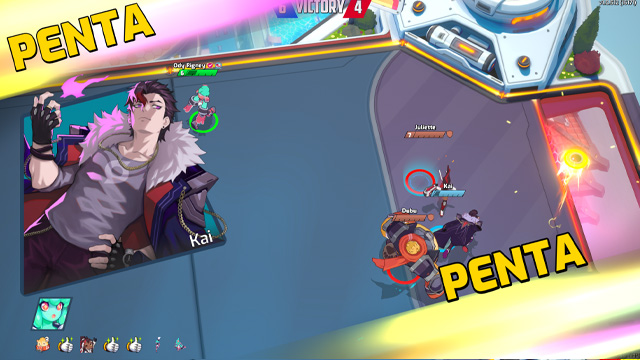
There’s arguably something a little soulless about a game being so laser-focused on a business model like this. However, as League of Legends’ former Project Lead and Growth Lead respectively, Henkel and Andrus certainly know more than most about how to maintain the popularity of a live service game. And perhaps this kind of bullish approach to luring in players is what Omega Strikers needs — Odyssey doesn’t have the bank-rolling capabilities other publishers can afford, so why not lean heavily on content creators to do their marketing for them?
If the game’s good enough, players will stick around regardless of what Twitch streamers say about it. As the old saying goes: if you build it, they will come. And as the new saying goes: if you give influencers a platform to advertise themselves and make money, they’ll play your damn video game.
